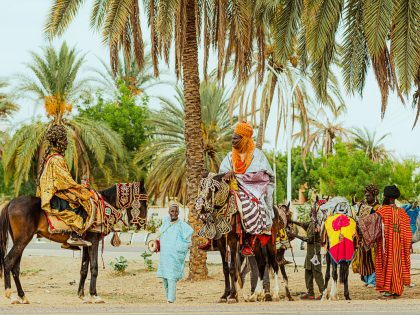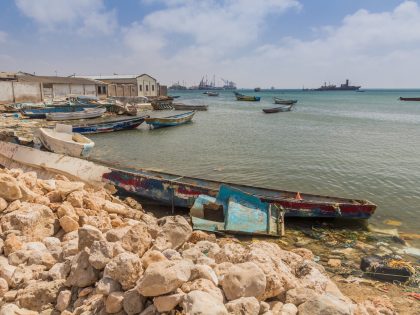Beyond the usual South African reporting on “Africa”
Journalism on and about the continent tends to veer between the extremes of neglect or stereotype on the one end, and touristic exoticism on the other.

Beijing Olympics opening ceremony 2008. Image Credit: U.S. Army Flickr
It is still not uncommon to hear South Africans say that they’re going on a business trip or holiday “in Africa” – as if their own country lies on another continent. We could blame this attitude on our history. During Apartheid, South Africa was politically and socially isolated from the rest of the continent (South African Airways flights weren’t even allowed to land in any other African countries). But a certain mindset also developed as a result of the Apartheid ideology of exceptionalism – the notion that because South Africa was “different” from other African countries, the same human rights of equality do not apply here. South Africans became good at navelgazing, and bad at seeing much further beyond than their northern borders. This means that South Africans can often more easily point out Barcelona than Bamako on a map.
The inverse of this knowledge gap can often be seen when traveling on the rest of the continent. Just look at the signs with Afrikaans surnames in the arrivals hall in Nairobi, or chat to your fellow tourists at breakfast in Zanzibar about the Super 14 rugby game, which you’d probably be able to watch in the hotel bar that afternoon on DStv, the satellite channel that stomped its footprint over large parts of Africa. The chances are good that your host knows more about South African history and politics than you know about theirs.
The media doesn’t exactly help. Compared to news beamed to us from Washington D.C. or London, we see very little coverage of other African countries in our newspapers, news sites and broadcast channels. The global impact of the political and economic power of the Untied States and Europe means that the minute details of Brexit or the Trump-vs-Clinton spectacle is beamed to our screens, but that you have to look hard to find nuanced information behind the headlines about, say, the Zambian election, political conflict in Burundi or renewed violence in South Sudan. This, while analyses show that the image of Africa has greatly improved in the past few years in international media. The Economist, that portrayed Africa as the “The Hopeless Continent” on that dreadful cover page of theirs in 2000, changed its tune to “Africa Rising” in 2011, a slogan that was consumed by Time Magazine a year later. However, critics point to the fact that this new-found optimism also sometimes reveals paternalistic stereotypes, or is based on a specific neoliberal ideal of Africa as an untapped market. But one simply has to follow sites like this one to see that fashion, music and sport in Africa gives journalists much more to report on than money and guns.
It is against this backdrop that two recent books about Africa, written by South African journalists, are welcome. Kevin Bloom and Richard Poplak’s Continental Shift: A Journey into Africa’s Changing Fortunes, and Liesl Louw-Vaudran’s South Africa: Superpower or Neocolonialist illustrate a fast-changing political and economic landscape on the continent. Bloom and Poplak’s reference point is the increasing influence of China in Africa, and the xenophobic reactions meted out against Chinese immigrants. A particular incident from 2011 in the settlement of Ganyesa, in the North West province of South Africa, is used as a leitmotiv to illustrate the violence that immigrants regularly meet with in this country. Four Chinese immigrants were burned to death in their shop – and the book insinuates that this was not an accident, that the shop-owners were murdered by local citizens. The case remains unresolved, thus Bloom and Poplak travelled to Ganyesa to speak to locals in an attempt to learn more about the situation. The truth remains out of reach, and as they broaden their discussion of how bigger geopolitical shifts are mirrored in the everyday details in African cities and towns, they return time and again to the fire in Ganyesa. As they travel through Namibia, Botswana, Zimbabwe, Nigeria, the Democratic Republic of Congo, Ethiopia, South Sudan and Central African Republic, their discoveries of new developments on political, economic and social terrain are punctuated by the threat of violence – old conflicts, prejudices and tensions mix with new ones and the result is not only intoxicating, but also often unhealthy.
Continental Shift is an entertaining and stimulating recounting of the authors’ experience of traveling thousands of kilometers and wading through academic books, historical documents, policy documents and news articles. It covers a broad range of topics – construction in Namibia, the building of a dam in Botswana, mining in Zimbabwe, Nollywood in Nigeria, food security in Ethiopia, realpolitik in South Sudan and conflict in Central African Republic. Continental Shift’s biggest achievement is its lively, and sometimes even humorous tone. It’s a heady mix of memoir, ethnography, analysis, travel writing and at times comes close to a type of political poetry. The accessibility and lucidity of this ambitious project is largely thanks to the distinctive style of writing – fans of Poplak’s political journalism in the Daily Maverick will be familiar with his destructive sense of irony. But this is also a gripping tale because of its reliance on first-hand experiences and field work, several conversations and interviews, and sharp observations on the ground.
The presentation and style is one of the big differences between Bloom and Poplak’s book, and that of Louw-Vaudran. Despite the fact that Louw-Vaudran is also an experienced journalist – she is a former Africa editor at Media24 – her script follows a more conventional style of reporting. Her material is partly drawn from her own interviews with political leaders, but she also relies quite heavily on second-hand sources. She is less likely to communicate her own point of view or observations than summarize those of her interviewees. As a result the book is an easy read, but one that lacks a distinctive voice. The transition from reporting to long form journalism is not as easy as it might seem.
Louw-Vaudran’s point of reference is the role that South Africa plays on the continent. She questions whether South Africa, as the largest economy on the continent and a country that set the political tone, especially under the leadership of Mandela and Mbeki, can also be seen as a neocolonial power on the African continent. Is South Africa a leader or a bully? Louw-Vaudran uses several significant news events across the past 20-odd years to investigate this question. The South African liberation struggle and the ANC’s years of exile in Lusaka provides the historical starting point, while the moral bankruptcy of the Zuma’s government ends the book on a pessimistic tone about the future of South Africa, and whether it can be trusted again as leader and example for other African nations. Between these historical extremes, Louw-Vaudran aims to highlight among other things Mbeki’s attempts to revitalize the Pan-African ideal, South Africa’s role in the African Union, as well as the country’s sometimes disastrous military interventions – for example the 13 South African soldiers that died in 2013 in Bangui in a conflict with Seleka rebels in the Central African Republic. Louw-Vaudran creates quite a negative image of lost opportunities by the South African government to collaborate more strongly with South African businesses across the continent, and remarks on the damage that xenophobic attacks in South Africa have done to the country’s image on the continent.
Journalism on and about the continent tends to veer between the extremes of neglect or stereotype on the one end, and touristic exoticism on the other. These two books manage, each in their own way, to steer a path between these extremes. The Africa they show us isn’t always “rising,” nor is it always pretty, but it is fascinating. And much more difficult to sum up than brief headlines can ever hope to do.
- A previous version of this review appeared in Afrikaans in the Media24 publication, Rapport.



















